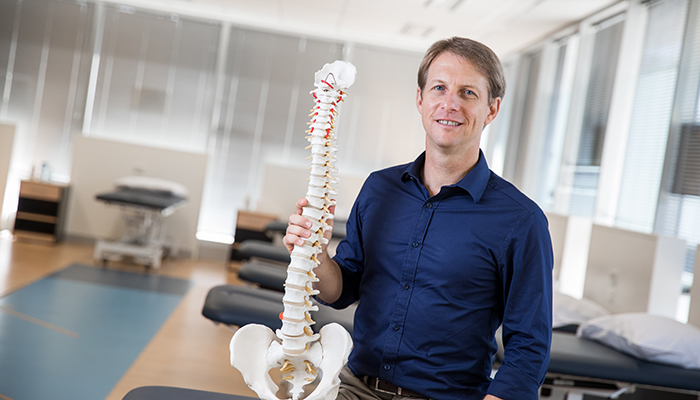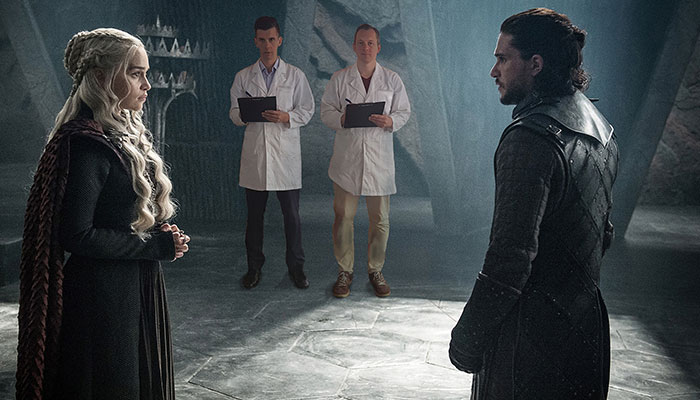A clinical trial of a personalised treatment method to help people to better understand their back pain and take charge of its management found lasting benefits well after treatment was complete.

About one in six Australians report chronic lower-back pain. It is the leading cause of disability worldwide, contributing to reduced physical and mental health and a loss of productivity. It is a common driver of early retirement.
While most people who suffer from episodes of lower back pain recover quickly, about 20 to 30 per cent have long-term pain lasting three months or more.
Cognitive functional therapy (CFT) uses intensive personalised sessions with specially trained physiotherapists to help people develop a positive mindset, learn to move in ways that ease their pain, regain confidence and make lifestyle changes.
This results in less pain-related anxiety and patients gaining the knowledge and confidence to do things they have been avoiding.
CFT was developed by Professor Peter O’Sullivan from the Curtin School of Allied Health in Perth and colleagues around the world. A team led by researchers from Curtin University and Sydney's Macquarie University has now published the findings of a study into its benefits in the latest edition of leading medical journal The Lancet.
Traditional approaches to managing chronic back pain include surgical interventions, massage, spinal manipulation, injections and other medications, but these typically produce only limited short-term relief. Importantly, none of these treatments address the range of factors contributing to pain.
One of the key differences with CFT is that the treatment is tailored to the individual, and takes into account their concerns and limitations of movement.
The RESTORE study
Nearly 500 people in Sydney and Perth took part in the study, which involved a randomised, controlled clinical trial across 20 physiotherapy clinics. Participants were divided into groups receiving CFT or whatever type of traditional care was recommended by their clinician.
CFT taught me to think about pain differently, but also to feel less anxious and have more confidence in the way I move.
To take part in the study, participants had to have had lower back pain for at least three months. On average, particpants had been living with back pain for an average of four years, and many had high levels of disability due to their condition.
They attended seven personalised CFT sessions over 12 weeks, followed by a booster session after six months.
Macquarie University Professor of Physiotherapy Mark Hancock led the trial in Sydney, in collaboration with the project lead Associate Professor Peter Kent from Curtin University.

Cutting edge: CFT pioneer Professor Mark Hancock, pictured, is teaching the new method to the next generation of physiotherapists.
“More than 80 per cent of the participants who received CFT reported they were satisfied with their treatment and its outcomes,” Professor Hancock says.
“They reported significant improvement in pain levels and being able to return to activities they had previously enjoyed.
“One of the most significant aspects of this trial is that the CFT participants were still reporting reduced pain and improved function 12 months later.
“Some people who we’ve had contact with following the study have told us they are still reaping the benefits three years later.”
Leah’s journey back to normal
Ten years ago, when she was 29, Leah Fitzgerald developed severe back pain that turned out to be a herniated disk.

No fear: Leah Fitzgerald no longer worries about hurting her back during normal activities after her CFT treatment. Images: Georgia Gowing
“For me it came out of nowhere, and it’s been a journey ever since of trying to prevent and manage pain,” Leah says.
“To begin with, I would get regular treatment from an osteopath, and I tried lots of things like acupuncture, alternative medicine, massage, using a standing desk and heat-pack treatment.
“Sitting upright for long periods was the most painful for me, so I dreaded long flights and car trips, and would spend time worrying about them and preparing for them.
“Every few years, I’d have a severe flare-up and need to take strong painkillers for a day or two, take some time off my usual activities and then gradually return to them.”
Leah had always been active, and she noticed that the fitter and stronger she was, the fewer problems she had with her back. But doctors had warned her to avoid certain activities and movements, and she became anxious about everyday actions like sitting at her office desk, running, bending down and lifting heavy items.
After joining the CFT trial, she noticed improvement within two to three months. Four years later, she is still enjoying the benefits.
“The psychological aspect for me was the biggest thing,” Leah says.
“Pain is not all in your mind – you have a real diagnosis – but CFT taught me to think about pain differently, but also to feel less anxious and have more confidence in the way I move.
“Before the treatment, when I had to bend down, I’d tense up because I was pre-empting the pain. I learnt that this mindset was actually putting me at more risk of aggravating the injury.
“I learnt that just by relaxing, breathing the right way and moving correctly, I can protect my back and feel less pain.
“Most importantly, I am not afraid to be active. My perspective has changed now that I’m not anticipating hurting myself or being in pain.”
While she does still get some pain, it has been reduced significantly. She has been able to start running again and can even do deadlifts at the gym.
Making CFT more widely available
At this stage, only the 18 physiotherapists in Sydney and Perth who were trained for the RESTORE study, as well as some of the developers of the approach are qualified to provide CFT to patient. However the team is investigating ways to scale up training, with a view to establishing a hybrid online/in-person learning model.
Professor Hancock says it is very important for the training to be comprehensive and competency based.
“We noticed it took quite a lot of training for physiotherapists to develop the skills and confidence to deliver the intervention to a high standard, despite the fact that many were already experienced,” he says.
“I’m teaching the principles of CFT as part of Macquarie University’s Doctor of Physiotherapy program, but it’s complex, and I don’t expect students to achieve full competency by graduation.
“We are looking forward to being able to make this treatment widely available, not only in Australia but around the world.”
The RESTORE study was led by researchers from Curtin University and Macquarie University, in partnership with Monash University, the University of Limerick, Imperial College London, the University of Southern Denmark, and the University of Western Australia. It was funded by the National Health and Medical Research Council and Curtin University.
A full list of current CFT practitioners is available at the RESTORE website.
Professor Mark Hancock is a Professor of Physiotherapy in the Macquarie University Faculty of Medicine, Health and Human Science.



